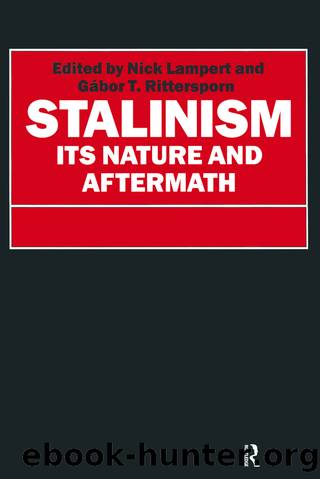Stanlinism by Nick Lampert

Author:Nick Lampert [Lampert, Nick]
Language: eng
Format: epub
Tags: Social Science, Ethnic Studies, General, Sociology, Regional Studies
ISBN: 9781315487830
Google: kMgYDQAAQBAJ
Publisher: Routledge
Published: 2016-09-16T03:23:52+00:00
Foremen and Labour Discipline
The problem of labour discipline was not peculiar to the 1930s, but the dimensions it assumed during that decade were sufficient to cause much alarm among trade union, state and party officials. Violations of labour discipline covered a multitude of sins - lateness, absenteeism, frequent job changing, the misuse of equipment, idling on the job, refusal to carry out instructions, attacks on unpopular workers and managerial-technical personnel - and stemmed from a variety of causes.58 There is no doubt, though, that the shortage of labour, which the key industrial sectors experienced as a chronic phenomenon after 1929, severely hampered efforts to combat such behaviour.
Trade union, Komsomol and Party committees developed a number of strategies to improve the standard of labour discipline. The organisation of collective responsibility via socialist competition, shock brigades and cost-accounting brigades was one. Visits to the homes of offenders, production-comrades courts, boards of disgrace (chernye doski), and denunciations in factory newspapers was another. A third, aimed at reducing labour turnover, was to offer incentives to workers to sign contracts committing them to remain at their jobs for several years, a scheme that went by the revealing name of samozakreplenie. Finally, the provision of special services and goods to outstanding workers was intended at least in part to spur others to emulate their example.
These techniques had some success in socialising the new industrial labour force, but the persistence of 'flitting', 'sponging', and other forms of 'petty bourgeois spontaneity' - by no means limited to new workers - provoked sterner measures. There is no need to rehearse the legislation that was aimed at increasingly restricting workers' mobility and freedom of action within their places of work.59 For our purposes, it is sufficient to note that the effectiveness of such legislation critically depended on its enforcement by enterprise management. And there was the rub. As managers have discovered the world over, fining, demoting, and dismissing workers have limits beyond which the fragile cooperation and consent of workers becomes jeopardised. But beyond this general rule, the imposition of such punitive measures in circumstances of a chronic labour shortage and super-ambitious production targets threatened to deprive Soviet enterprises of their most vital resources, labour power.60
These considerations, perfectly rational from the perspective of individual enterprise directors, in fact vitiated the impact of the coercive legislation. Vesting in enterprise management the power of enforcement, political authorities repeatedly condemned its preference for 'the path of least resistance'. It is in this context of conflicting pressures and demands with respect to labour discipline that we can analyse the role of foremen.
On 3 January 1933, Trud reported that two workers had been arrested for stabbing and seriously wounding a shock worker who had been promoted to foreman at the Sacco and Vanzetti machine construction factory in Stalingrad. The account of this incident was as emblematic as were those from the late 1920s to which reference was made at the outset of this paper. Whereas foremen's rude behaviour was cited in those accounts as provocation
Download
This site does not store any files on its server. We only index and link to content provided by other sites. Please contact the content providers to delete copyright contents if any and email us, we'll remove relevant links or contents immediately.
Chaco's Northern Prodigies : Salmon, Aztec, and the Ascendancy of the Middle San Juan Region after AD 1100 by Paul F. Reed(355)
Law Enforcement Interpersonal Communication and Conflict Management by Brian Douglas Fitch(347)
Digital International Relations by Unknown(346)
Critical Perspectives on Human Security : Rethinking Emancipation and Power in International Relations by David Chandler; Nik Hynek(329)
Skilled interpersonal communication: Research, theory and practice, Fifth edition by Owen Hargie(327)
The Enduring Color Line in U.S. Athletics by Krystal Beamon Chris M. Messer(325)
Evidence-Based Policy Making in Labor Economics by Hamermesh Daniel S.;Nottmeyer Olga K.;Nottmeyer Olga;King Sarah;King Sarah;King Sarah;(298)
EPSO CAST Political affairs EU policies: How to succeed in the selection procedure by Franco Reverte José María(290)
Writing Public Policy - A Practical Guide to Communicating in the Policy Making Process by Catherine F. Smith(272)
Criminological Theory in Context by John Martyn Chamberlain(270)
Tibeton Yoga Its Secret Doc by Evans-Wentz(267)
Threshold Concepts in Women's and Gender Studies by Christie Launius Holly Hassel(264)
Rothschild and Early Jewish Colonization in Palestine (Geographical Perspectives on the Human Past) by Ran Aaronsohn(263)
Positive Psychology and Spirituality in Counselling and Psychotherapy (Conflict, Ethics, and Spirituality, 12) by unknow(261)
Social Problems, Social Issues, Social Science by James Wright(259)
Play in child development and psychotherapy: toward empirically supported practice by Sandra W. Russ(254)
Cognitive Development in Infancy and Childhood (Elements in Child Development) by Mary Gauvain(252)
Latin American Politics and Society by Gerardo L. Munck & Juan Pablo Luna(224)
What Makes a Social Crisis?: The Societalization of Social Problems by Jeffrey C. Alexander(220)
